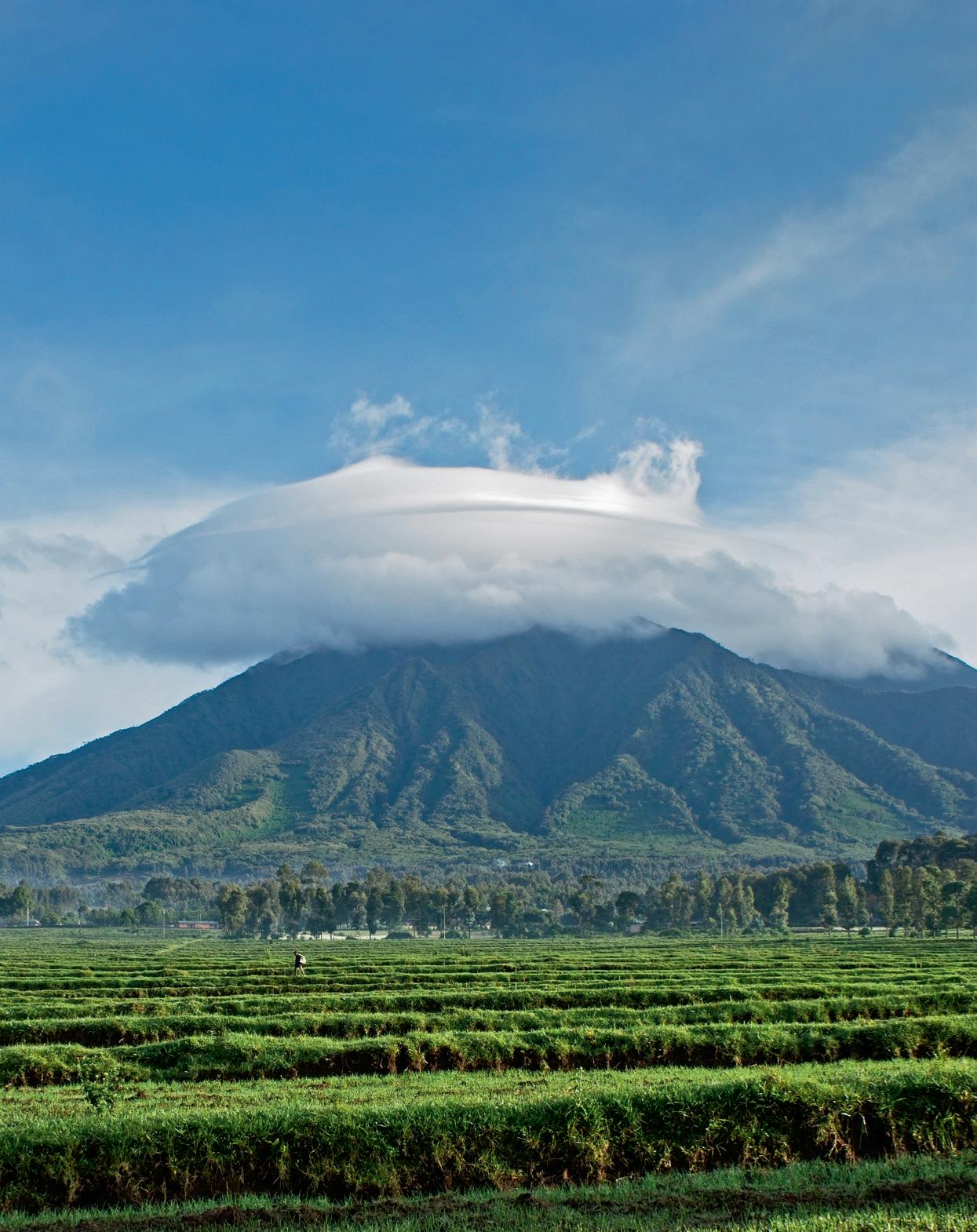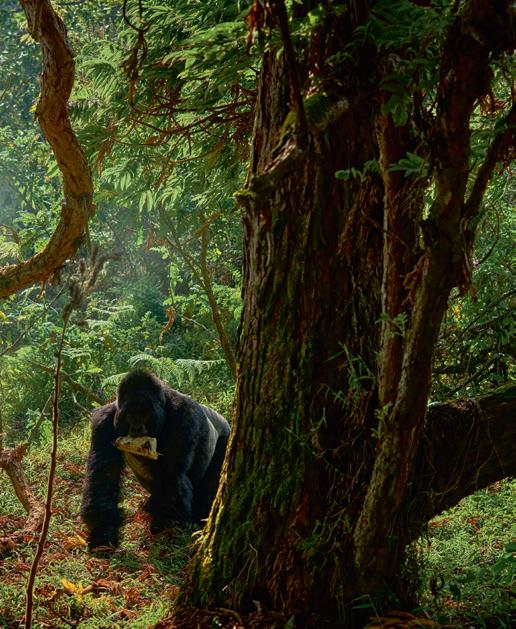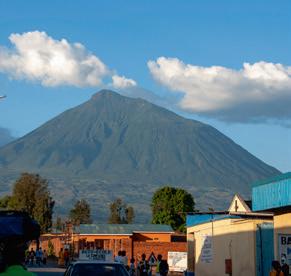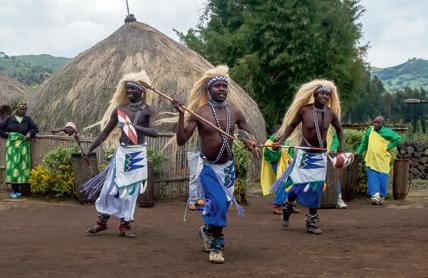
5 minute read
Eight reasons to visit Volcanoes National Park
Volcanoes National Park is world-renowned for its population of endangered mountain gorillas that freely roam the steep slopes of the majestic Virunga range. While the primates may be the main allure, the mountain peaks and their surrounding park have an array of wonders. Here are a few things to know before exploring this natural wonder in northwest Rwanda.
1: Gorillas aren’t the only primates
Volcanoes National Park is one of only three places on Earth where you can see the rare mountain gorilla in its natural habitat. These gentle giants are the park's star attraction, but they are not the only primates that call this lush landscape home. Golden monkeys, with their striking orange-gold fur, are also endemic to this region, as are the black-and-white colobus monkeys you will spot swinging through the canopy. You can book trekking excursions to see the golden monkey up close, with the largest groups often found in the bamboo forests of Mount Sabyinyo.
2: Dian Fossey's burial site
If you're gorilla trekking, consider stopping to honour the woman who helped save them. Renowned primatologist Dian Fossey arrived at Volcanoes National Park in 1967 and dedicated two decades to studying and protecting the mountain gorillas.
Her legacy lives on through the Karisoke Research Centre, which she established between Mounts Karisimbi and Bisoke, and through the continued survival of the gorillas she fought for.
Fossey was tragically murdered in 1985, a crime widely believed to be linked to her outspoken stance against poaching. Today, visitors can hike from the base of Mount Bisoke to visit her tomb and the site of her former research camp.
3: Buhanga Eco-Park
Once the site of royal coronations, this ancient forest lies at the edge of Volcanoes National Park. Winding walking trails lead through towering, centuries-old trees, connecting sacred places: stone thrones, ceremonial springs, and caves still used for spiritual rituals.
Its stillness and quiet add to the reverence. Here, it’s just you, the rustle of 300-year-old branches, and birdsong. A local guide will walk you through the forest, sharing the cultural and ecological importance of its trees, plants, and animals and how they are all being safeguarded for the future.
4: Musanze Caves
These ancient caves, believed to have formed due to volcanic activity 62 million years ago, served as a refuge for locals during the Genocide Against the Tutsis. Today, guided tours allow visitors to explore the intricate labyrinth tunnels. Located in the foothills of Volcanoes National Park, the Musanze Caves can be easily included in your trip itinerary.
5: Bird Paradise
The park is home to more than 290 bird species, including 17 found only within East-Central Africa’s Albertine Rift—one of the most biodiverse regions on the continent. These endemic species include the multi-coloured Rwenzori turaco, the iridescent Rwenzori double-collared sunbird, and the orange-tailed Archer’s ground robin. The park’s bamboo, grassland, and montane forests create an ideal habitat for nesting and foraging. And as birdwatchers scan the canopy, they do so against the breathtaking backdrop of the park’s volcanic terrain.

6: Hiking the Volcanoes
Volcanoes National Park spans the towering peaks of five dormant volcanoes in the Virunga range, each with its own story. Dominating them all is Mount Karisimbi, rising to 4,507 metres—the highest point in the park. When encircled by lens-shaped clouds, the summit is especially striking. This mesmerising weather phenomenon is formed by high-altitude winds colliding with the rugged terrain. While snow at the peak is now a rare sight, but it once crowned the mountain so regularly that it inspired its name: Karisimbi, meaning "white shell" in Kinyarwanda. For outdoor adventurers, the two-day trek to Karisimbi’s summit is both challenging and rewarding. Those looking for a shorter climb can choose a day hike to Mount Bisoke’s crater lake.

7: Twin Lakes
Even in a region renowned for its breathtaking landscapes, the twin lakes of Burera and Ruhondo stand out as striking. Their beauty lies in the contrast between the lakes’ deep blue waters and the elevated, forested slopes of the surrounding Virunga Mountains.
Located just a short drive from Musanze, the lakes are easily accessible via a scenic 20-minute hike. Once there, visitors can immerse themselves in the local way of life: fishing remains central to the community, and guests are welcome to hop aboard a hand-carved wooden boat—either to join in the catch or simply to soak in the serene surroundings.
The lakes are prime hunting grounds for birdwatchers. Their fish-rich waters attract an array of birds, including herons, kingfishers, cormorants, and cranes.
8: Community visits

Aside from fishing on the Twin Lakes, visitors to the region can engage with local communities in several meaningful ways. One of the most popular experiences is visiting the Iby'iwacu Cultural Village (also known as the Gorilla Guardians Village), which offers a rich immersion into Rwandan culture. Guests can participate in traditional music and dance, learn about pre-colonial Rwandan life, and learn from the residents who help preserve and share these cultural practices. Since 2005, the Rwandan government has allocated five per cent of the income from gorilla trekking (which attracts over 20,000 visitors annually) to community-based initiatives like this village. Other immersive options include homestays in traditional Rwandan households, where visitors meet the members of the indigenous Batwa community and get a first-hand sense of everyday life. The Batwa, who were displaced when the Volcanoes National Park was established, but are now in the process of being resettled. Near the park entrance, there’s a Batwa homestead where visitors can engage in traditional activities such as pottery making, storytelling, and cooking, offering a window into their ancestral lifestyle.








